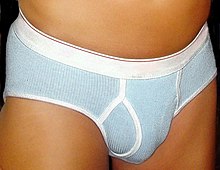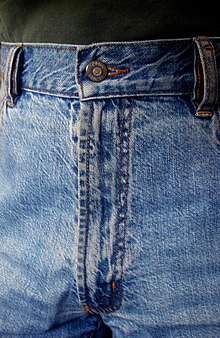Bib
The bib is the name commonly used in parts of the German-speaking area for the opening on the front of the trousers , which is usually closed with buttons or a zipper . Other terms are trouser case , Hosenladen , fly, fly and pants door , the technical language word of the textile industry for the opening procedure .
Word origin
The starting point for the word “bib” was the tape or strap with which the slit between the two trouser legs was tied together; mhd. laz means "piece of string on the garment" and comes from old French. laz "fetter, laces". Since this lacing was covered with a piece of fabric (flap), the term was gradually transferred to this. Hosenlätze in this form there are today only in leather pants and guild pants . - The variants trouser trap and trouser drawer also refer to this flap, only here the development of meaning went the opposite way, namely from the flap to the opening.
In the case of dungarees , on the other hand, the term “bib” refers to the top of the pants, like a bib apron . In terms of linguistic history, it is about the same word, only the meaning of "bib" has shifted from "lace" to "flap over the lace" to "flap over the upper body".
history
The trousers of the Teutons were sewn together from several pieces of fabric and had a gusset in the crotch , but no opening. They were held together in the waistband by a belt . In the Middle Ages, which was initially under the outer garment Brouche a kind of worn underpants with no front opening, to be buttoned leg warmers . Around the 14th century, these leg warmers became a type of pantyhose that was worn with a doublet . For the first time, these tight-fitting trousers had a flap - the bib - probably for practical reasons. In the 15th century it was made larger and more decorative. This led to restrictive rules within the medieval dress codes , for example in Nuremberg around 1480: “After a lewd and shameful habit arose among a number of men, namely that they let their bibs on their trousers be enlarged without need and that they should be made respectable during dances and elsewhere Women and virgins bare and uncovered without shame, which (...) is unseemly, the Council decided (...) that in the future every man (...) should not bare, uncovered or visible his bib on his trousers may wear. "
But in the 16th century the traditional dress of the mercenaries prevailed, with short, wide trousers and a clearly emphasized bib, which was also stuffed in the form of a so-called pubic capsule to emphasize the genitals and draw attention to them. The nobility adopted this fashion, which was also imitated by the bourgeoisie. The preferred trouser shape at this time was the padded short army drum . After 1600 the pubic capsule gradually disappeared, and moderately wide harem pants appeared. For the first time, the fly was provided with decorative buttons. At the time of the Rococo , the nobility wore tight-fitting breeches with buttoned fly. In France around 1750, the wide flap took the place of the slit, a conspicuous flap that was closed with two buttons at the waistband. It was often emphasized by courtiers by wearing ringing curls on the waistband.
After 1800, men's fashion gradually became more matter-of-fact and simple, with the end of dandy fashion, striking decorative elements almost completely disappeared. The front trouser fastener was now purely functional and has been covered with a fabric strip since the middle of the 19th century.
swell
- ^ Etymological dictionary of German. Developed under the direction of Wolfgang Pfeifer. Akademie Verlag, Berlin 1989 and several new editions.
- ↑ Gundula Wolter: The packaging of the male sex. An illustrated cultural history of the pants , Marburg 1988, p. 38.
literature
- Gundula Wolter : The packaging of the male sex. An illustrated cultural history of the pants . Jonas, Marburg 1988, ISBN 3-922561-77-2 (paperback edition: Aufbau, Berlin 2001, ISBN 3-7466-8060-3 )


